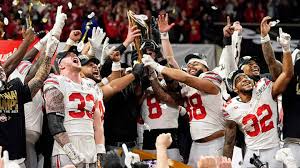Ratings for Ohio State-Notre Dame: Supporters Are Overreacting to the Attendance at the College Football Playoff National Championship
The College Football Playoff (CFP) National Championship is one of the biggest events in American sports, bringing together the best of the best from the world of college football. The matchup between Ohio State and Notre Dame is an exciting one for fans of both teams, as well as the millions of others who enjoy the intense competition that college football offers. However, a particular issue surrounding the game has been making waves: the attendance at the stadium, and the reactions from fans and analysts alike.
In the weeks leading up to the game, there was a growing sense of anticipation, with Ohio State and Notre Dame being two of the most storied programs in the history of college football. Both teams had earned their spots in the National Championship through impressive seasons, with Ohio State finishing as the second-ranked team in the nation and Notre Dame earning a hard-fought spot as the fourth seed. The matchup seemed poised to be a classic, and the excitement was palpable.
However, as the day of the game approached, there were growing concerns about the attendance at the game. With ongoing questions surrounding the COVID-19 pandemic, there was uncertainty about how many fans would actually be allowed to attend the game. These concerns were exacerbated by reports that the attendance figures for the game were not as high as some had anticipated. For some, this raised questions about the appeal of the game and the level of interest in college football as a whole.
Despite the legitimate concerns about attendance and the broader implications of the pandemic on the sports world, it’s important to recognize that many of the reactions to the attendance figures are somewhat overblown. Fans and analysts alike seem to be reading too much into the attendance numbers, focusing too heavily on the negative aspects of the situation rather than understanding the context and challenges that the college football world faces in this unprecedented time.
Understanding the Context: The Impact of COVID-19
The first and most important factor to consider when discussing the attendance at the College Football Playoff National Championship is the ongoing impact of the COVID-19 pandemic. Over the past few years, the sports world has been turned upside down as leagues, teams, and events have had to adjust to the realities of a global health crisis. Restrictions on public gatherings, travel limitations, and health protocols have all contributed to changes in the way that sports events are held.
For college football, this meant that the 2020 season was unlike any other. Many teams were forced to play in empty or near-empty stadiums for the majority of the season. Some programs opted for limited fan attendance, while others had to completely close their doors to fans. For the National Championship, these restrictions were still in place to some extent. Even though the situation had improved compared to earlier in the pandemic, the virus was still a concern, and health and safety protocols remained a priority.
When it comes to attendance at the National Championship, it’s important to remember that the number of people allowed in the stadium was still limited due to the pandemic. The NCAA and the CFP organizers made the decision to allow only a reduced capacity at the game, taking into account both the safety of fans and the realities of the ongoing pandemic. This is not an unusual decision in the current climate, and it reflects the broader trend of events with limited attendance across all sports.
For some fans, however, this reality is difficult to accept. Many are used to seeing packed stadiums for marquee games, and the sight of empty or sparsely filled seats can be jarring. But this reaction is somewhat misplaced. The decision to limit attendance was a necessary one to ensure the safety of everyone involved, and it was made with the best interests of the fans, players, and coaches in mind.
The Overreaction: Why the Attendance Issue Is Being Blown Out of Proportion
Despite the valid context of the pandemic, some fans and analysts have chosen to focus heavily on the attendance numbers, framing it as a sign of a broader problem with the popularity of college football. This is where the overreaction begins. The notion that a reduced attendance at the National Championship somehow indicates a decline in interest or a lack of excitement for the game is not only unfair but also unfounded.
First and foremost, the attendance issue cannot be viewed in isolation. It is part of a much larger conversation about the challenges facing live sports during a global pandemic. People are still adjusting to new realities, and many fans have not yet returned to attending large events in person. This is a natural consequence of the pandemic, and it does not reflect any lack of enthusiasm for college football. In fact, the ratings for college football games have been strong throughout the season, with high viewership for key matchups and bowl games.
The National Championship, too, saw impressive TV ratings, with millions of viewers tuning in to watch Ohio State and Notre Dame battle it out for the title. The game was widely anticipated, and fans flocked to their screens to witness the clash of two iconic programs. In this context, the attendance at the game becomes less of an issue. College football is still as popular as ever, but the circumstances surrounding live attendance have made it difficult for fans to attend in person.
Another point to consider is that the National Championship is not just a game for the local fanbases of the teams involved. While Ohio State and Notre Dame have large and passionate followings, college football is a national sport that attracts fans from all corners of the country. Many fans who would normally travel to a game like this may have opted not to attend due to travel restrictions, personal safety concerns, or the desire to watch from the comfort of their homes. The convenience of watching on television or streaming online is an attractive option, especially when it means avoiding the hassle and potential risks of traveling during a pandemic.
Furthermore, the nature of the College Football Playoff system itself has changed the dynamic of how fans experience the National Championship. The inclusion of more teams in the playoff means that the pool of teams and fanbases is larger than ever before. While the National Championship may traditionally have drawn larger crowds in the past, the expansion of the playoff system means that the fanbases of the teams involved may not be as concentrated in one region, making it harder for some fans to make the trek to the game.
The Bigger Picture: The Future of College Football and National Championships
While it’s easy to get caught up in the immediate reaction to attendance figures, it’s important to take a step back and consider the bigger picture. College football, and the College Football Playoff system, are going through a period of transition. The landscape of the sport is evolving, with changes in conference alignments, playoff formats, and media deals. The impact of these changes on fan engagement and attendance is something that will become clearer in the years to come.
The COVID-19 pandemic, though challenging, has also accelerated certain shifts in the way fans interact with sports. The popularity of streaming services, social media, and digital platforms has made it easier for fans to follow games and interact with their favorite teams without necessarily attending in person. This shift may lead to changes in the way future National Championships are viewed and experienced. It’s possible that we may see a greater focus on virtual and digital engagement with fans, allowing for more inclusive experiences that transcend geographic limitations.
Looking forward, college football will likely adapt to the evolving landscape of sports and entertainment. The attendance issues at the National Championship, while significant in the moment, are only a small part of the overall picture. As the world continues to recover from the pandemic and as the sport of college football continues to grow and evolve, there will be new opportunities for fans to engage with the game in ways that go beyond simply attending in person.
Conclusion: A Necessary Perspective on College Football’s Future
In conclusion, the overreaction to the attendance at the College Football Playoff National Championship between Ohio State and Notre Dame is understandable, but ultimately misguided. While attendance numbers may be lower than expected due to the lingering impact of the COVID-19 pandemic, this should not be seen as a sign of waning interest in the game or in college football as a whole. The pandemic has created unprecedented challenges for live sports, and the decision to limit attendance was a necessary one to prioritize the health and safety of all involved.
Rather than focusing on attendance figures, fans should appreciate the fact that the National Championship took place at all, considering the circumstances of the past few years. College football continues to be a popular and beloved sport, with millions of fans tuning in to watch the biggest games of the season. The future of the sport is bright, and the National Championship will continue to be a major event for years to come.
As the world adjusts to the new normal, fans and analysts alike should take a step back and consider the broader context of the situation. College football is not defined by attendance at one game but by the passion, excitement, and tradition that the sport brings to millions of people. The ratings for Ohio State-Notre Dame should serve as a reminder of that enduring passion and enthusiasm for the game. The future of college football, with or without packed stadiums, remains incredibly bright.



